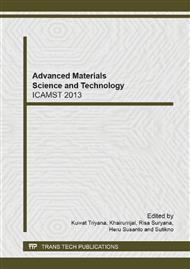p.78
p.85
p.89
p.95
p.100
p.104
p.108
p.112
p.116
Synthesis of Fe2O3/C Nanocomposite Using Microwave Assisted Calcination Method
Abstract:
Fe2O3/C nanocomposites were successfully synthesized using microwave assisted calcination method. Ferric (III) chloride hexahydrate (FeCl36H2O), sodium hydroxide (NaOH), and dextrose monohydrate (C6H12O6H2O) were used as precursors. A microwave oven of 2.445 GHz with a power of 600 W for 20 minutes was employed during the syntheses. Calcination was performed in a simple furnace at 350 °C for 30 min. The molar ratio of C:Fe is the only process parameter. From Scanning Electron Microscope images, the average particle size were 199 nm and 74 nm for the samples with molar ratio of C:Fe of 1:2 and 1:1, respectively. X-ray diffractometer spectra showed that the obtained samples have γ-Fe2O3 (maghemite) crystal structure. Using the Scherrer method, the crystallite size were 61.7, 58.8, 52.5, and 48.8 nm for the samples with the molar ratios of C:Fe of 1:3, 1:2, 1:1, and 2:1, respectively. It means that the crystallite size of the nanocomposite decreases with the increase of the molar ratio of carbon to iron (C:Fe). The Brunauer-Emmett-Teller characterization showed that the surface area as high as 255.6 m2/g is achieved by of the Fe2O3/C nanocomposite with the molar ratio of C:Fe of 1:1.
Info:
Periodical:
Pages:
100-103
Citation:
Online since:
February 2014
Keywords:
Price:
Сopyright:
© 2014 Trans Tech Publications Ltd. All Rights Reserved
Share:
Citation:


